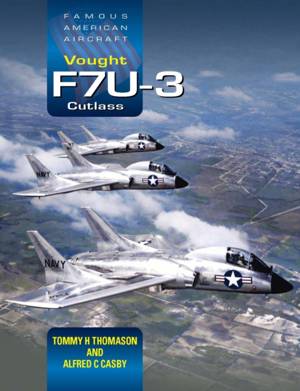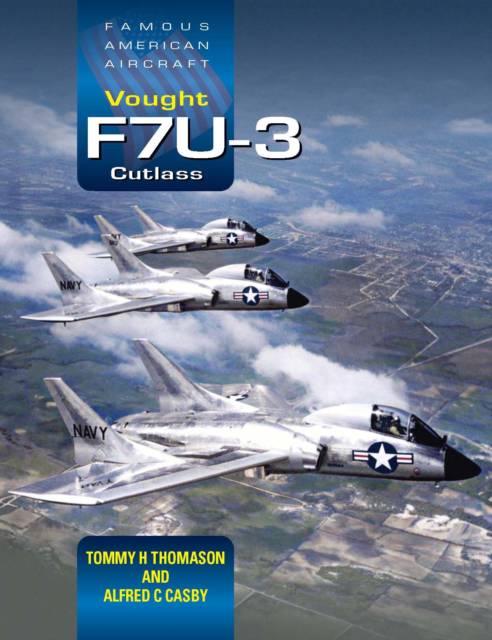
- Afhalen na 1 uur in een winkel met voorraad
- Gratis thuislevering in België vanaf € 30
- Ruim aanbod met 7 miljoen producten
- Afhalen na 1 uur in een winkel met voorraad
- Gratis thuislevering in België vanaf € 30
- Ruim aanbod met 7 miljoen producten
Zoeken
Omschrijving
The Chance Vought F7U Cutlass was an innovative but flawed tail-less jet fighter that faced numerous developmental challenges and mixed operational reviews.
The Chance Vought F7U Cutlass was ahead of its time. In 1948, when it first flew, it could hardly have been more exotic or state-of-the-art: a tail-less fighter to be powered by two afterburning jet engines. It was not only to be carrier-based but also climb quicker and be faster than the Air Force's new swept-wing North American F-86 Sabre. Developmental problems resulted in it taking too long to reach operational squadrons, which partly accounts for its relatively unsuccessful career.
The Cutlass was designed too soon to benefit from the discovery of the area rule, which doomed it to transonic performance in level flight. Similarly, its lack of a horizontal tail was intended in part to address the transonic pitch-control difficulties being encountered at the time but they proved to be avoidable with one. Unfortunately, no horizontal tail resulted in it not only being radical in appearance but also having challenging handling qualities at approach speed.
The F7U-3's service introduction was also accomplished before the Navy perfected a rigorous process for transitioning pilots to new airplanes, particularly important in the case of the Cutlass and its unusual handling qualities, one of which resulted in a rare aeronautical phenomenon, the post-stall gyration. It was also first deployed before the introduction of the angled-deck concept that greatly reduced the degree of difficulty in landing high-performance jet fighters back aboard a carrier.
The F7U Cutlass did eventually join the fleet and deploy, albeit to mixed reviews. It is often unfairly included on shortlists of the world's worst jet fighters. It was actually innovative in many respects. This new, detailed history of the development and operation of the type provides a more balanced perspective on what was a fascinating aircraft.
The Chance Vought F7U Cutlass was ahead of its time. In 1948, when it first flew, it could hardly have been more exotic or state-of-the-art: a tail-less fighter to be powered by two afterburning jet engines. It was not only to be carrier-based but also climb quicker and be faster than the Air Force's new swept-wing North American F-86 Sabre. Developmental problems resulted in it taking too long to reach operational squadrons, which partly accounts for its relatively unsuccessful career.
The Cutlass was designed too soon to benefit from the discovery of the area rule, which doomed it to transonic performance in level flight. Similarly, its lack of a horizontal tail was intended in part to address the transonic pitch-control difficulties being encountered at the time but they proved to be avoidable with one. Unfortunately, no horizontal tail resulted in it not only being radical in appearance but also having challenging handling qualities at approach speed.
The F7U-3's service introduction was also accomplished before the Navy perfected a rigorous process for transitioning pilots to new airplanes, particularly important in the case of the Cutlass and its unusual handling qualities, one of which resulted in a rare aeronautical phenomenon, the post-stall gyration. It was also first deployed before the introduction of the angled-deck concept that greatly reduced the degree of difficulty in landing high-performance jet fighters back aboard a carrier.
The F7U Cutlass did eventually join the fleet and deploy, albeit to mixed reviews. It is often unfairly included on shortlists of the world's worst jet fighters. It was actually innovative in many respects. This new, detailed history of the development and operation of the type provides a more balanced perspective on what was a fascinating aircraft.
Specificaties
Betrokkenen
- Auteur(s):
- Uitgeverij:
Inhoud
- Aantal bladzijden:
- 384
- Taal:
- Engels
Eigenschappen
- Productcode (EAN):
- 9781800352940
- Verschijningsdatum:
- 23/11/2024
- Uitvoering:
- Hardcover
- Formaat:
- Genaaid
- Afmetingen:
- 218 mm x 279 mm
- Gewicht:
- 1837 g

Alleen bij Standaard Boekhandel
+ 111 punten op je klantenkaart van Standaard Boekhandel
Beoordelingen
We publiceren alleen reviews die voldoen aan de voorwaarden voor reviews. Bekijk onze voorwaarden voor reviews.











